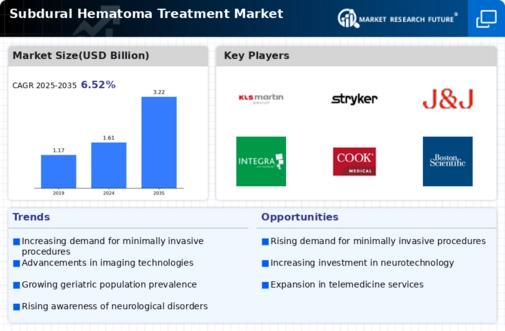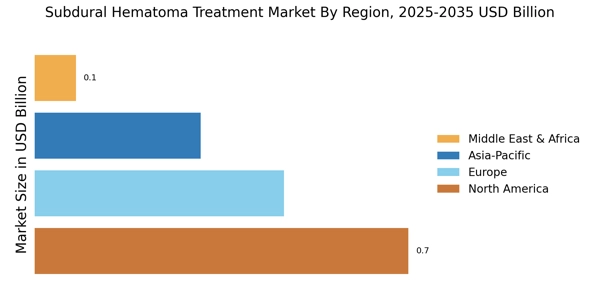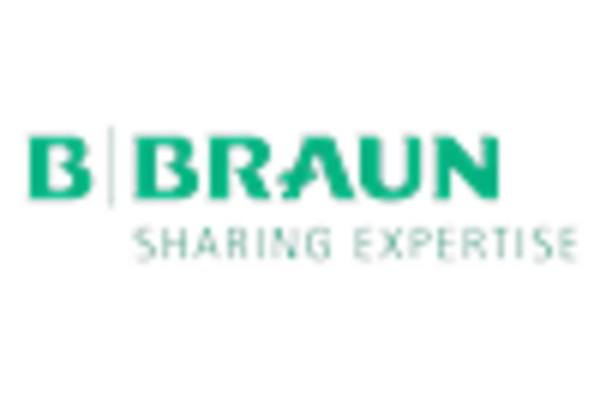Advancements in Surgical Techniques
Advancements in surgical techniques are significantly influencing the Subdural Hematoma Treatment Market. Innovations such as endoscopic surgery and minimally invasive procedures have transformed the approach to treating subdural hematomas. These techniques not only reduce recovery times but also minimize complications associated with traditional open surgeries. The introduction of advanced imaging technologies, such as intraoperative ultrasound, has further improved surgical outcomes. As a result, healthcare providers are increasingly adopting these modern techniques, which are projected to enhance patient outcomes and satisfaction. The market for surgical instruments and devices used in these procedures is also expected to expand, with a projected growth rate of approximately 6% annually. This evolution in surgical practices is likely to play a crucial role in shaping the future of the Subdural Hematoma Treatment Market.
Rising Awareness and Education Programs
Rising awareness and education programs regarding brain injuries are contributing to the growth of the Subdural Hematoma Treatment Market. Public health campaigns aimed at educating individuals about the risks and symptoms of subdural hematomas are becoming more prevalent. These initiatives encourage early diagnosis and treatment, which are critical for improving patient outcomes. Additionally, healthcare professionals are receiving enhanced training on recognizing and managing subdural hematomas, further promoting timely intervention. As awareness increases, more patients are likely to seek treatment, thereby driving demand in the market. The potential for increased patient engagement and proactive healthcare measures suggests a positive outlook for the Subdural Hematoma Treatment Market, with an anticipated growth rate of approximately 5% in the near future.
Technological Innovations in Diagnostic Tools
Technological innovations in diagnostic tools are reshaping the Subdural Hematoma Treatment Market. The development of advanced imaging techniques, such as MRI and CT scans, has significantly improved the accuracy of diagnosing subdural hematomas. These tools enable healthcare providers to identify the condition at earlier stages, facilitating timely intervention and treatment. Moreover, the integration of artificial intelligence in imaging analysis is enhancing diagnostic precision, potentially leading to better patient outcomes. As the demand for accurate and efficient diagnostic solutions grows, the market for these technologies is expected to expand. The increasing reliance on sophisticated diagnostic tools is likely to drive growth in the Subdural Hematoma Treatment Market, with projections indicating a growth rate of around 7% in the coming years.
Growing Investment in Healthcare Infrastructure
Growing investment in healthcare infrastructure is a significant driver for the Subdural Hematoma Treatment Market. Governments and private entities are increasingly allocating resources to enhance healthcare facilities, particularly in neurosurgery departments. This investment is aimed at improving access to advanced treatment options for conditions like subdural hematomas. Enhanced infrastructure facilitates the acquisition of state-of-the-art medical equipment and training for healthcare professionals, which is essential for effective treatment. Furthermore, the establishment of specialized centers for brain injuries is likely to increase the availability of comprehensive care. As healthcare spending continues to rise, the Subdural Hematoma Treatment Market is expected to benefit from improved service delivery and patient outcomes, potentially leading to a market growth rate of around 4% over the next few years.
Increasing Incidence of Traumatic Brain Injuries
The rising incidence of traumatic brain injuries (TBIs) is a primary driver for the Subdural Hematoma Treatment Market. TBIs, often resulting from falls, accidents, or sports injuries, have been reported to affect millions annually. As awareness of the consequences of TBIs grows, the demand for effective treatment options, including surgical interventions and conservative management, is likely to increase. The prevalence of subdural hematomas, particularly among the elderly population, further emphasizes the need for specialized treatment protocols. In fact, studies indicate that the incidence of subdural hematomas is expected to rise, potentially leading to a market growth rate of over 5% in the coming years. This trend underscores the necessity for healthcare systems to adapt and enhance their treatment capabilities in the Subdural Hematoma Treatment Market.


















Leave a Comment